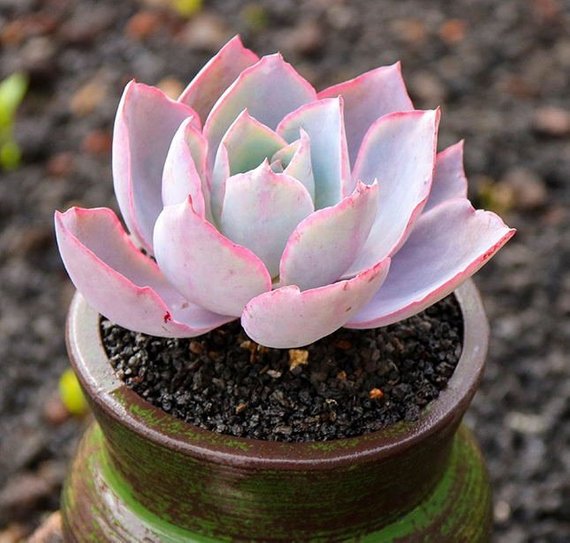Characteristics: Leaves are tightly arranged in a circular pattern with distinct edges. The leaf surface is smooth with a white powder, and slight creases can be seen from the leaf tip to the leaf center. When the leaf is split in half, the edge is very thin, resembling a knife edge, slightly turning towards the leaf surface, with reddening edges. The leaves are light blue or light purple with a powdery coating, with new leaves leaning towards blue and old leaves resembling a beautiful sunset, with a slight white powder on the leaf surface.
Uses: Ornamental.
Distribution: Originally from Mexico, now cultivated in many places.
Maintenance:
Soil:
The Echeveria Afterglow has a strong adaptability to soil. When cultivating Echeveria Afterglow, it is recommended to use loose, fertile, and well-draining soil as the cultivation substrate. A mixture of humus soil, garden soil, river sand, and pumice can be used as the cultivation substrate. Regularly turn over the soil and change the pot every year to prevent soil compaction.
Light:
The Echeveria Afterglow is a light-loving plant. During the spring and autumn seasons, it should be placed in a bright location to maintain its glossy leaves. However, strong sunlight should be avoided in summer, and shading measures should be taken to prevent leaf sunburn.
Watering:
The Echeveria Afterglow is drought-resistant but intolerant to waterlogging. When cultivating Echeveria Afterglow, water should be strictly controlled. Watering should be done after the soil has dried, and watering should be done appropriately to maintain moisture. Waterlogging can cause root rot.
Precautions:
The Echeveria Afterglow has poor drought tolerance. During hot summer temperatures, it is necessary to frequently spray water around the leaves to cool them down and strictly control the amount of watering to keep the soil slightly dry. When the temperature is low in winter, the Echeveria Afterglow should be moved to a warm indoor location to prevent frost damage.
Proper shading during noon
During the high temperatures of summer, the Echeveria Afterglow may enter a dormant state. To determine if it is in dormancy, observe whether the leaves are tightly clustered and growing slowly. If it is still growing, normal care is needed. In the case of dormancy, where the leaves are tightly clustered, resembling a bud, shading is necessary during high noon temperatures. Warm sunlight can be provided in the morning or evening.
In the summer, when the Echeveria Afterglow is dormant, it can be placed on the east-west balcony or in the backyard, under a canopy, especially during high noon temperatures to prevent leaf sunburn. Although there is some white powder on the leaves, strong sunlight in summer still requires appropriate shading.
Moderate watering during dormancy
During the high temperatures of summer, the Echeveria Afterglow may enter a dormant state, requiring less water. Therefore, watering should be reduced accordingly. Excessive watering can lead to root rot. However, in dry weather in the north, if watered too little, the roots may dry up and die. Therefore, watering needs to be carefully managed.
In some humid areas in the south, watering can be stopped after the Echeveria Afterglow enters dormancy during the high temperatures of summer. Even if watering is stopped, the Echeveria Afterglow can still survive. However, to make the Echeveria Afterglow more beautiful in summer, watering should be adjusted according to the soil moisture, allowing the Echeveria Afterglow to thrive.
In the north, where the weather is relatively dry, watering should be done in the morning or evening after the soil has dried slightly to prevent waterlogging in the flowerpot.
During dry weather, it is also necessary to frequently spray water around the pot in the evening, but avoid spraying water into the center of the leaves to prevent rotting.
Moreover, during the high temperatures of summer, continuous rainy weather may occur. In this case, the Echeveria Afterglow also needs to be moved to a sheltered place to prevent waterlogging in the pot, leading to root rot. Additionally, frequent rain can easily lead to leaf and heart rot.
Pruning old leaves
During the high temperatures of summer, if watering is reduced and sunlight is strong, the leaves of the Echeveria Afterglow may easily become dry. In this case, the dry leaves should be removed. This not only makes the Echeveria Afterglow more beautiful but also reduces nutrient loss and minimizes the occurrence of pests and diseases.
When cleaning old leaves from the Echeveria Afterglow, it is necessary to remove the dried leaves and those that are about to wither. Additionally, after pruning old leaves, the wounds should be treated with a fungicide, such as carbendazim, to reduce the invasion of pathogens, allowing the Echeveria Afterglow to better survive the summer.
Prevention is better than cure
During the high temperatures of summer, the Echeveria Afterglow is also prone to diseases and pests, which are related to poor ventilation. Poor ventilation, coupled with high temperatures and humidity, makes the Echeveria Afterglow particularly susceptible to diseases and pests. Additionally, during the high temperatures of summer, many pests like to feed on the Echeveria Afterglow, causing it to easily become damaged.
Therefore, during the high temperatures of summer, the Echeveria Afterglow should be kept in a well-ventilated environment. For indoor Echeveria Afterglow, it is necessary to frequently open windows for ventilation in the morning or evening to make the indoor air fresher and improve ventilation.
Moreover, during the high temperatures of summer, it is necessary to spray insecticide on the Echeveria Afterglow every 15-20 days to prevent diseases and pests, ensuring that the Echeveria Afterglow continues to thrive throughout the summer.
